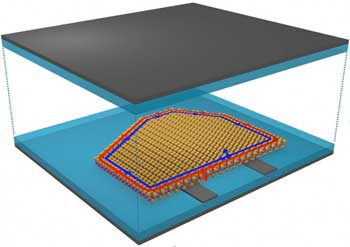| Posted: Jan 09, 2018 |
An exotic state of matter discovered in 2-D material
(Nanowerk News) After flaking a single layer of tungsten ditelluride off a larger crystal, scientists used it in a specially designed transistor. The transistor allowed electrical transport measurements. In the experiments, electrical current moved only at the edges (Nature Physics, "Edge conduction in monolayer WTe2").
|
|
This is the first realization of controlled, edge-restricted conduction in this new class of ultrathin materials. The edge conductivity was good in spite of the roughness at the torn edges of the flake.
|
 |
| An exotic state of matter called a topological insulator has been observed in 3-D materials and artificial nanostructures, but not in simple 2-D materials—until now. The sketch shows a transistor made of a single layer of tungsten ditelluride, platinum electrical contacts (gray bars), and an insulating material (blue) that provides air-tight encapsulation. Voltage is applied to the graphene sheets (dark grey) on the top and bottom to control the sheet conductivity. When the conductivity is very low, the current between the contacts flows only at the edge of the 2-D material—as expected for a 2-D topological insulator! (Image: David Cobden)
|
|
This is the first of a new family of materials that can be used to explore the physics of topological insulators. These insulators are an odd state of matter. The material’s interior doesn’t conduct electrons, but the edges do. It opens the door to tailoring topological electronic properties by stacking different thin sheets, or 2-D materials.
|
|
These exotic 2-D materials could be used as a platform for energy-efficient computing (spintronics) and to solve today’s intractable challenges with quantum computing.
|
|
Like graphene, the semi-metal tungsten ditelluride (WTe2) can be prepared in a single monolayer. Tellurium atoms sandwich the transition metal tungsten in each layer. These sandwiched transition metal materials are important for future electronics and photonics.
|
|
Scientists have predicted that WTe2 in monolayer form has the exotic electronic properties of the class of materials known as topological insulators. However, the surface of WTe2 oxidizes in air, destroying the electronic properties.
|
|
Now, researchers have made devices from WTe2, down to a single layer thick, that are air-stable and have good electrical contacts. Surprisingly, the team found that in the case of a single layer, the sheet became insulating at liquid nitrogen temperatures when no gate voltage was applied. For large enough positive or negative contact voltages, the electrical current switched on, as in a transistor.
|
|
Most remarkably though, the insulating state is not fully insulating—it still conducts at the edges. Multi-contact electrical transport measurements and scanning probe techniques verified this conductivity at the edge. This edge conduction is just what is expected for a 2-D topological insulator.
|
|
It exhibits another topological signature in its electronic spectrum: electron states at all energies, without a gap normally found in semiconductors and insulators. The special edge conductivity is sensitive to a magnetic field pointing parallel to the layer. These observations are consistent with the edge conduction channels behaving like quantum mechanical wires in which the electron magnetic direction, known as spin, is locked to the direction of electron travel. The edge of the material can, therefore, be used to filter electrons by spin direction.
|
|
The only previous 2-D topological insulator candidates were quantum wells in sophisticated semiconductor heterostructures. Likewise, this 2-D material can readily be combined with layers of superconducting and magnetic materials. It may thus provide the basis of a platform for spin-based or topologically protected quantum computing.
|

